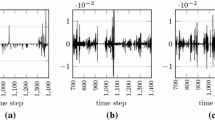Abstract
The aim of this study is to discuss the influence of investors’ loss-cut behavior to the market stock price and the investors’ asset distribution by using the artificial market simulation. The loss-cut behavior is strongly related to the anchoring effect, which is one of the investors’ cognitive biases. The anchoring effect is a psychological heuristic that influences the way people intuitively assess probabilities. The investor in the actual market is modeled as the agent in the artificial market. The agent has the prediction rule of the stock price and the anchoring coefficient related to the strength of the anchoring effect. Once the agent predicts the stock price by the prediction rule, he determines the order price and the order amount from the predicted stock price according to the strength of the anchoring effect. Agents’ orders are gathered to the market and the stock price is determined according to the Itayose method. In the numerical examples, two kinds of agents with different anchoring effects are modeled; Type A and Type B agents. Type A agents have stronger anchoring effect than the Type B agents. The simulation results reveal that the Type-A agents’ order price tends to uctuate more violently than the Type B agents, and that the Type A agents tend to lose more asset than the Type B.
Similar content being viewed by others
References
Belsky, G. and T. Gilovich (2000) Why Smart People Make Big Money Mistakes And How To Correct Them, Simon and Schuster.
Buhmann, M. D. (2005) Radial Basis Functions: Theory and Implementations, Cambridge University.
Iguchi, T. (2000) My Billion Dollar Education, Jona Books.
Izumi, K., H. Matsui, and Y. Matsuo (2007) “Socially embedded multi agent based simulation of financial market,” in E. H. Durfee, M. Yokoo, M. N. Huhns and O. Shehory (eds), Proceedings of 6th International Joint Conference on Autonomous Agents and Multiagent Systems (AAMAS, Hawaii, USA, May 14–18, 2007), p. 175.
Kahneman, D. and A. Tversky (1979) “Prospect theory: An analysis of decisions under risk,” Econometrica 47: 263–291.
Leeson, N. (1996) Rogue Trader, Penguin.
Lifson, L. E. and R. A. Geist (1999) The Psychology of Investing, John Wiley and Sons.
Moody, J. and Darken, C. J. (1989) “Fast learning in networks of locally tuned processing units,” Neural Computation 1: 281–294.
Poggio, T. and F. Girosi (1990) “Networks for approximation and learning,” Proceedings of IEEE 78: 1484–1487.
Author information
Authors and Affiliations
Corresponding author
About this article
Cite this article
Zhai, F., Takahashi, K., Shinoki, H. et al. Influence of Investors’ Loss-cut Behavior to Artificial Market. Evolut Inst Econ Rev 7, 133–153 (2010). https://doi.org/10.14441/eier.7.133
Published:
Issue Date:
DOI: https://doi.org/10.14441/eier.7.133




